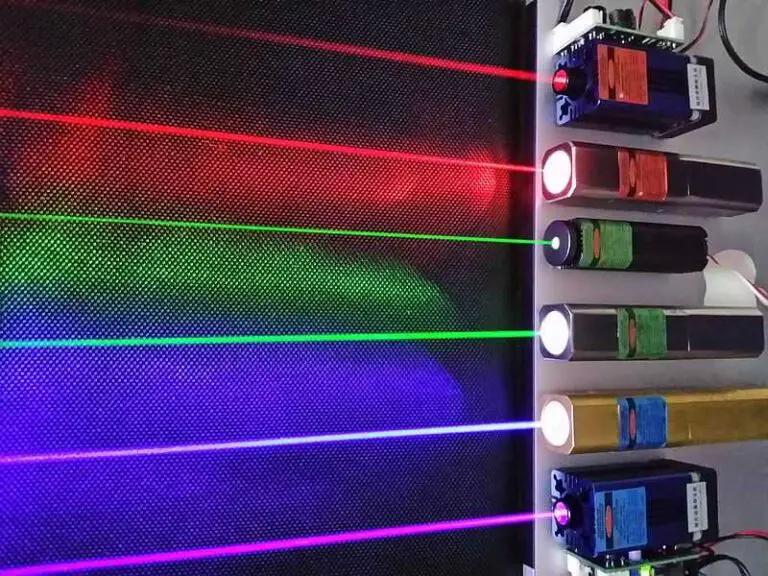5 Light Energy Examples Explained
Light energy examples are; optically-amplified laser light light, combustion-derived light, electric light, solar radiation, and hot-metal photons.
This article discusses light energy examples, as follows;
1). Optically-Amplified Laser Light (as one of the Light Energy Examples)
Optically-amplified laser light is an example of light energy, that is given off by a laser device.
The principle of optical amplification is based on the use of photon-collision to increase the intensity of light emitted by a medium.
It is important to note that the source of light energy in a laser is usually electricity [4]. Often, a monochromatic bulb is used to introduce white light into the laser device, which then uses optical materials like crystals to induce light-wave oscillations that produce higher-intensity output.
Lasers differ from optical amplifiers, and increase light-wave intensity through polarization, so that vibrations are made to occur along a definite axis [3].

2). Combustion-derived Light
Combustion gives off light energy alongside heat, as materials react with oxygen and are thermally decomposed.
The production of light energy by combustion occurs as a result of the energizing of atoms as their particles vibrate due to heat absorption. This phenomenon can be referred to as incandescence.
The light produced is most-commonly observed as flame from the burning material, especially when combustion occurs in the presence of significant amounts of oxygen.
Combustion represents one of the simplest chemical-reaction processes that can produce light energy. Light from combustion was the primary means of indoor and night-time lighting for several centuries, till the invention of the electric light bulb.
3). Electric Light (as one of the Light Energy Examples)
Electric light is one of the most common light energy examples in a modern setting or society.
This refers to light that is given off by manmade electric devices like the incandescent light bulb and the light-emitting diode (LED).
Incandescent light bulb works by atomic excitation and photon emission; where a high-melting point metallic conductor like tungsten is continuously charged with electricity, so that its internal resistance induces heating that causes its atoms vibrate and give off light through the phenomenon of incandescence [5].
The metallic conductor is called a filament, and it is usually surrounded by inert gas to prevent unwanted reactions and disintegration.
Light-emitting diode (LED) produces light energy based on the principle of electro-luminescence; where current flowing through a semiconductor diode causes it to emit photons into its surroundings [6].
The LED model for electric lighting is far more energy-efficient that the incandescent model, and therefore is replacing it for most functions.
Electric light is one of the simplest and most flexible-to-use examples of light energy.
It is important to note that light energy itself can be used to generate electricity, through the phenomenon of photoelectric conversion. This is the principle behind solar panels and other manmade solar energy systems.
4). Solar Radiation
Solar radiation is the ultimate source of light energy on Earth.
Various types of light come from solar radiation, including ultraviolet, infrared and visible light [1].
Radiation is itself one of the mechanisms of thermal energy transfer, and is also responsible for the transmission of light energy to the Earth's surface.
The ultimate source of solar radiation is nuclear fusion, whereby hydrogen atoms in the Sun combine to form helium [2].
Light energy from the Sun is an important form of renewable energy that is used for electricity generation with photoelectric systems. These systems capture photons in sunlight and use them to energy electrons and produce current streams.
5). Hot-Metal Photons (as one of the Light Energy Examples)
When metal is heated, its atoms become energized so that they vibrate at high frequency.
This leads to emission of photons that are observed as visible light, the heated metal glows.
To calculate the energy of a photon of light, the following formula is used;
E (J) = hf = hc/λ ---(1)
Where;
E= Energy of photon (Joules)
h= Max Planck's constant= 6.63 * 10^-34 Joule seconds
f= Frequency (Hertz)
c= Velocity (Meters per second)
λ= Wave length (Meters)
Light energy from hot metals can be understood at the molecular level as being a result of the continuous collision of atomic particles in the material aa these atoms gain energy from a heat source.
It is the same collisions that cause heat to be transferred from one end of a conductor to an opposite end, or from one conductive material to another.

Conclusion
Light energy examples are;
1. Optically-amplified laser light
2. Combustion-derived Light
3. Electric Light
4. Solar Radiation
5. Hot-Metal Photons
References
1). Стерхов, A.; Loshkarev, I. Y. (2019). "Determination of the proportion of natural light in solar radiation using the method of conversion of lighting units into energy." Journal of Physics Conference Series 1353(1):012002. Available at: https://doi.org/10.1088/1742-6596/1353/1/012002. (Accessed 16 February 2023).
2). Fardaei, J. (2020). "Quantum Solar System." Available at: https://www.researchgate.net/publication/347506167_Quantum_Solar_System. (Accessed 16 February 2023).
3). Ivaniga, T.; Ivaniga, P. (2017). "Comparison of the Optical Amplifiers EDFA and SOA Based on the BER and -Factor in C-Band." Hindawi. Available at: https://doi.org/10.1155/2017/9053582. (Accessed 16 February 2023).
4). Jinjun, L.; Shaui, S.; Xiaochuan, G. (2011). "Research on High Frequency direct Modulation of laser light source." Physics Procedia 19:442-446. Available at: https://doi.org/10.1016/j.phpro.2011.06.190. (Accessed 16 February 2023).
5). Onnink, A. J.; Schmitz, J.; Kovalgin, A. (2019). "How hot is the wire: Optical, electrical, and combined methods to determine filament temperature." Thin Solid Films 674. Available at: https://doi.org/10.1016/j.tsf.2019.02.003. (Accessed 16 February 2023).
6). Singh, S. (2009). "Basics of Light Emitting diodes, Characterizations and Applications." Handbook of Light Emitting and Schottky Diode Research. Available at: https://www.researchgate.net/publication/200071029_Basics_of_Light_Emitting_diodes_Characterizations_and_Applications. (Accessed 16 February 2023).




